Shubham Gupta
IBM Research Paris-Saclay
LLM-based Contrastive Self-Supervised AMR Learning with Masked Graph Autoencoders for Fake News Detection
Aug 26, 2025Abstract:The proliferation of misinformation in the digital age has led to significant societal challenges. Existing approaches often struggle with capturing long-range dependencies, complex semantic relations, and the social dynamics influencing news dissemination. Furthermore, these methods require extensive labelled datasets, making their deployment resource-intensive. In this study, we propose a novel self-supervised misinformation detection framework that integrates both complex semantic relations using Abstract Meaning Representation (AMR) and news propagation dynamics. We introduce an LLM-based graph contrastive loss (LGCL) that utilizes negative anchor points generated by a Large Language Model (LLM) to enhance feature separability in a zero-shot manner. To incorporate social context, we employ a multi view graph masked autoencoder, which learns news propagation features from social context graph. By combining these semantic and propagation-based features, our approach effectively differentiates between fake and real news in a self-supervised manner. Extensive experiments demonstrate that our self-supervised framework achieves superior performance compared to other state-of-the-art methodologies, even with limited labelled datasets while improving generalizability.
Audio Prototypical Network For Controllable Music Recommendation
Jul 31, 2025Abstract:Traditional recommendation systems represent user preferences in dense representations obtained through black-box encoder models. While these models often provide strong recommendation performance, they lack interpretability for users, leaving users unable to understand or control the system's modeling of their preferences. This limitation is especially challenging in music recommendation, where user preferences are highly personal and often evolve based on nuanced qualities like mood, genre, tempo, or instrumentation. In this paper, we propose an audio prototypical network for controllable music recommendation. This network expresses user preferences in terms of prototypes representative of semantically meaningful features pertaining to musical qualities. We show that the model obtains competitive recommendation performance compared to popular baseline models while also providing interpretable and controllable user profiles.
LiSTEN: Learning Soft Token Embeddings for Neural Audio LLMs
May 24, 2025Abstract:Foundation models based on large language models (LLMs) have shown great success in handling various tasks and modalities. However, adapting these models for general-purpose audio-language tasks is challenging due to differences in acoustic environments and task variations. In this work, we introduce LiSTEN Learning Soft Token Embeddings for Neural Audio LLMs), a framework for adapting LLMs to speech and audio tasks. LiSTEN uses a dynamic prompt selection strategy with learnable key-value pairs, allowing the model to balance general and task-specific knowledge while avoiding overfitting in a multitask setting. Our approach reduces dependence on large-scale ASR or captioning datasets, achieves competitive performance with fewer trainable parameters, and simplifies training by using a single-stage process. Additionally, LiSTEN enhances interpretability by analyzing the diversity and overlap of selected prompts across different tasks.
ReTreever: Tree-based Coarse-to-Fine Representations for Retrieval
Feb 11, 2025Abstract:Document retrieval is a core component of question-answering systems, as it enables conditioning answer generation on new and large-scale corpora. While effective, the standard practice of encoding documents into high-dimensional embeddings for similarity search entails large memory and compute footprints, and also makes it hard to inspect the inner workings of the system. In this paper, we propose a tree-based method for organizing and representing reference documents at various granular levels, which offers the flexibility to balance cost and utility, and eases the inspection of the corpus content and retrieval operations. Our method, called ReTreever, jointly learns a routing function per internal node of a binary tree such that query and reference documents are assigned to similar tree branches, hence directly optimizing for retrieval performance. Our evaluations show that ReTreever generally preserves full representation accuracy. Its hierarchical structure further provides strong coarse representations and enhances transparency by indirectly learning meaningful semantic groupings. Among hierarchical retrieval methods, ReTreever achieves the best retrieval accuracy at the lowest latency, proving that this family of techniques can be viable in practical applications.
LAST SToP For Modeling Asynchronous Time Series
Feb 04, 2025



Abstract:We present a novel prompt design for Large Language Models (LLMs) tailored to Asynchronous Time Series. Unlike regular time series, which assume values at evenly spaced time points, asynchronous time series consist of timestamped events occurring at irregular intervals, each described in natural language. Our approach effectively utilizes the rich natural language of event descriptions, allowing LLMs to benefit from their broad world knowledge for reasoning across different domains and tasks. This allows us to extend the scope of asynchronous time series analysis beyond forecasting to include tasks like anomaly detection and data imputation. We further introduce Stochastic Soft Prompting, a novel prompt-tuning mechanism that significantly improves model performance, outperforming existing fine-tuning methods such as QLoRA. Through extensive experiments on real world datasets, we demonstrate that our approach achieves state-of-the-art performance across different tasks and datasets.
Docling: An Efficient Open-Source Toolkit for AI-driven Document Conversion
Jan 27, 2025



Abstract:We introduce Docling, an easy-to-use, self-contained, MIT-licensed, open-source toolkit for document conversion, that can parse several types of popular document formats into a unified, richly structured representation. It is powered by state-of-the-art specialized AI models for layout analysis (DocLayNet) and table structure recognition (TableFormer), and runs efficiently on commodity hardware in a small resource budget. Docling is released as a Python package and can be used as a Python API or as a CLI tool. Docling's modular architecture and efficient document representation make it easy to implement extensions, new features, models, and customizations. Docling has been already integrated in other popular open-source frameworks (e.g., LangChain, LlamaIndex, spaCy), making it a natural fit for the processing of documents and the development of high-end applications. The open-source community has fully engaged in using, promoting, and developing for Docling, which gathered 10k stars on GitHub in less than a month and was reported as the No. 1 trending repository in GitHub worldwide in November 2024.
Samudra: An AI Global Ocean Emulator for Climate
Dec 05, 2024

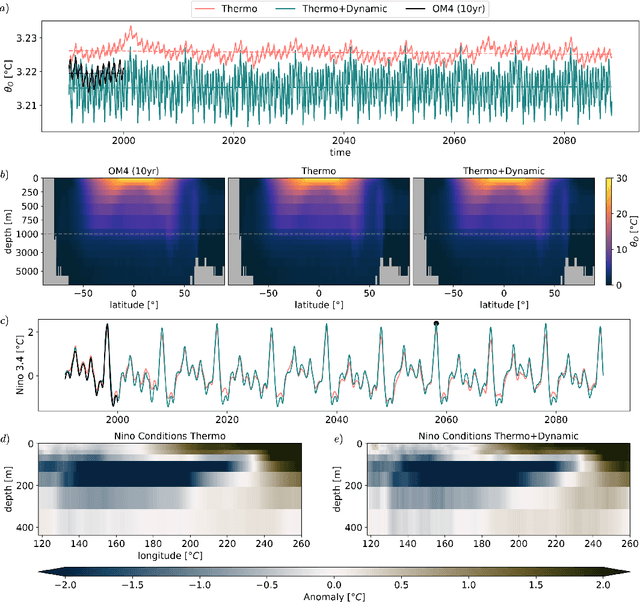
Abstract:AI emulators for forecasting have emerged as powerful tools that can outperform conventional numerical predictions. The next frontier is to build emulators for long-term climate projections with robust skill across a wide range of spatiotemporal scales, a particularly important goal for the ocean. Our work builds a skillful global emulator of the ocean component of a state-of-the-art climate model. We emulate key ocean variables, sea surface height, horizontal velocities, temperature, and salinity, across their full depth. We use a modified ConvNeXt UNet architecture trained on multidepth levels of ocean data. We show that the ocean emulator - Samudra - which exhibits no drift relative to the truth, can reproduce the depth structure of ocean variables and their interannual variability. Samudra is stable for centuries and 150 times faster than the original ocean model. Samudra struggles to capture the correct magnitude of the forcing trends and simultaneously remains stable, requiring further work.
Know Your RAG: Dataset Taxonomy and Generation Strategies for Evaluating RAG Systems
Nov 29, 2024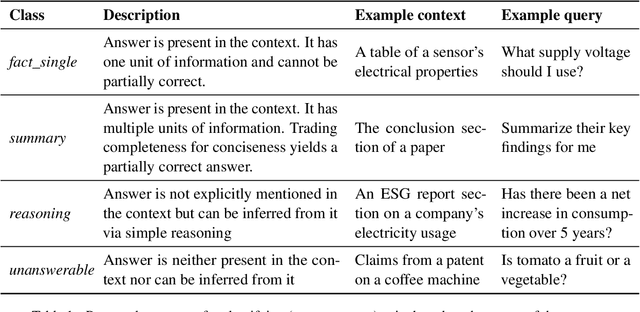
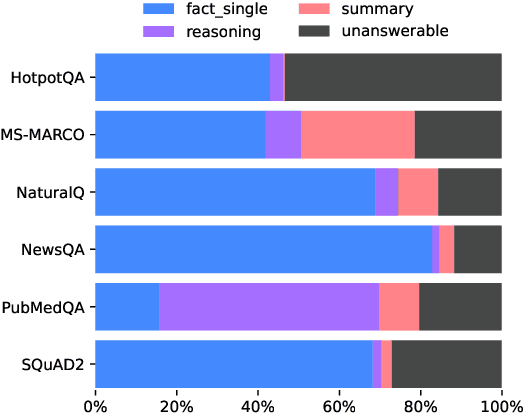
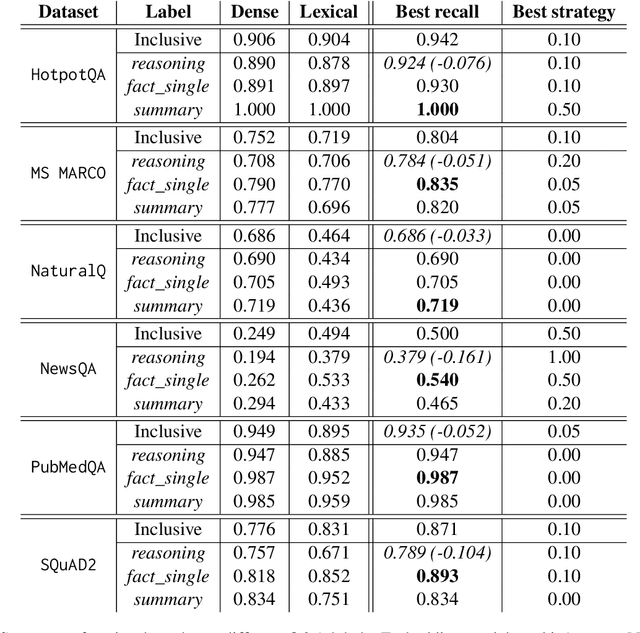
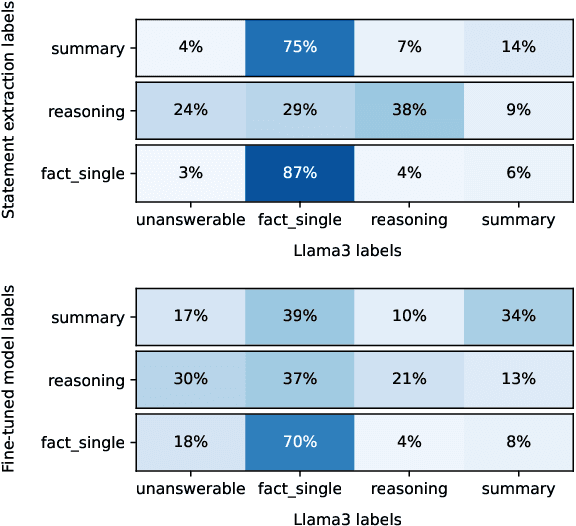
Abstract:Retrieval Augmented Generation (RAG) systems are a widespread application of Large Language Models (LLMs) in the industry. While many tools exist empowering developers to build their own systems, measuring their performance locally, with datasets reflective of the system's use cases, is a technological challenge. Solutions to this problem range from non-specific and cheap (most public datasets) to specific and costly (generating data from local documents). In this paper, we show that using public question and answer (Q&A) datasets to assess retrieval performance can lead to non-optimal systems design, and that common tools for RAG dataset generation can lead to unbalanced data. We propose solutions to these issues based on the characterization of RAG datasets through labels and through label-targeted data generation. Finally, we show that fine-tuned small LLMs can efficiently generate Q&A datasets. We believe that these observations are invaluable to the know-your-data step of RAG systems development.
Dynamic HumTrans: Humming Transcription Using CNNs and Dynamic Programming
Oct 07, 2024Abstract:We propose a novel approach for humming transcription that combines a CNN-based architecture with a dynamic programming-based post-processing algorithm, utilizing the recently introduced HumTrans dataset. We identify and address inherent problems with the offset and onset ground truth provided by the dataset, offering heuristics to improve these annotations, resulting in a dataset with precise annotations that will aid future research. Additionally, we compare the transcription accuracy of our method against several others, demonstrating state-of-the-art (SOTA) results. All our code and corrected dataset is available at https://github.com/shubham-gupta-30/humming_transcription
Statements: Universal Information Extraction from Tables with Large Language Models for ESG KPIs
Jun 27, 2024Abstract:Environment, Social, and Governance (ESG) KPIs assess an organization's performance on issues such as climate change, greenhouse gas emissions, water consumption, waste management, human rights, diversity, and policies. ESG reports convey this valuable quantitative information through tables. Unfortunately, extracting this information is difficult due to high variability in the table structure as well as content. We propose Statements, a novel domain agnostic data structure for extracting quantitative facts and related information. We propose translating tables to statements as a new supervised deep-learning universal information extraction task. We introduce SemTabNet - a dataset of over 100K annotated tables. Investigating a family of T5-based Statement Extraction Models, our best model generates statements which are 82% similar to the ground-truth (compared to baseline of 21%). We demonstrate the advantages of statements by applying our model to over 2700 tables from ESG reports. The homogeneous nature of statements permits exploratory data analysis on expansive information found in large collections of ESG reports.
 Add to Chrome
Add to Chrome Add to Firefox
Add to Firefox Add to Edge
Add to Edge